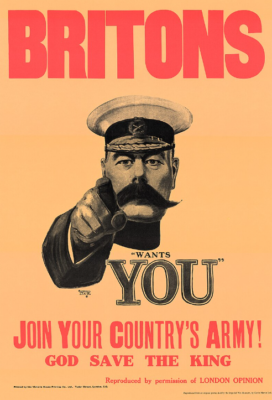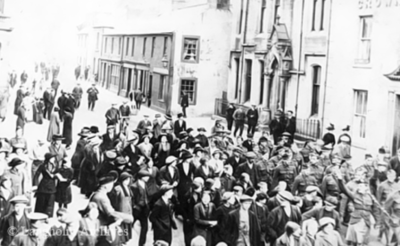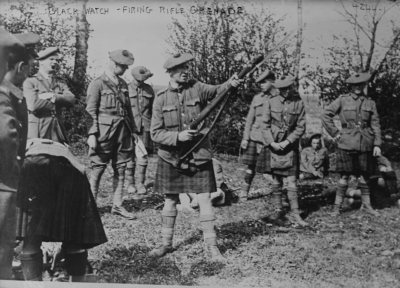On 7th August 1914, three days after the UK declared war on Germany, Secretary of State for War Lord Kitchener appealed for young men aged 19 to 30 to reinforce the army. The age limit was higher (45) for ex-soldiers and was soon raised to 35 for new recruits.

Although they were volunteers (until conscription began in January 1916), they were to be trained to join the ‘regular’ army, as distinct from the Territorial Force which consisted of part-time volunteers organised on a county basis, typically serving in the UK only. Kitchener’s recruits were sometimes referred to as the ‘New Army’ or ‘Kitchener’s Army’.
Langholm already had a number of men in the regular army and an active local Territorial unit. A few in the town had fought in South Africa in the Second Boer War (1899-1902).
A week after the declaration of war, existing Langholm Territorials were called upon to report for training in Dumfries with one day’s notice. In the morning of Thursday 13th August they gathered at the Buccleuch Hall under the command of Lieutenant James McGeorge, the son of a local solicitor, and made their way to Market Square. The town band led them from there to the railway station to catch the 7.10 am train, sent off by many townsfolk.

The local newspaper, the Eskdale & Liddesdale Advertiser, established a Roll of Honour of serving residents and former residents with close links to the town. By January 1916, there were 474 on the list, belonging to a wide variety of units but mostly the King’s Own Scottish Borderers (KOSB), which focussed on Dumfriesshire for its recruitment:
| Regiment/Corps/Service | Number |
|---|---|
| King’s Own Scottish Borderers | 140 |
| Army Service Corps | 31 |
| Gordon Highlanders | 27 |
| Canadian Corps | 25 |
| Royal Scots | 23 |
| Black Watch | 15 |
| Yeomanry | 15 |
| Royal Army Medical Corps | 12 |
| Royal Engineers | 12 |
| Royal Garrison Artillery | 12 |
| Navy | 12 |
| Others | 150 |
| Total | 474 |
Volunteers had significant latitude in the choice of which regiment they joined. They were influenced by factors such as their family members’ previous military service, styles of uniform (particularly kilts in Scotland) and which regiment their friends and relatives were joining. Some parts of the country had ‘Pals battalions‘ formed from particular communities, including the 11th (Lonsdale) Battalion, The Border Regiment, formed in Carlisle, which several Langholm residents joined. The KOSB was in some respects a proxy for a Pals battalion in the Langholm area.
Kilts were worn by some Highland regiments early in WWI, including in battle, such as the Gordon Highlanders and they Black Watch. However, they were largely replaced by trousers as more effective protection when chemical weapons began to be used.
